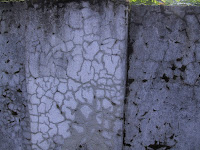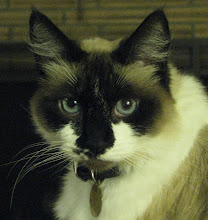What I submitted is true (write about what you know), concrete (don't tell; show) and coherent (first person narrator, minimal artsy jargon). I feel more secure about my writing than I do about my art. Here it is. But dang... how did all those passive constructions get by the editor? And I see I used the word "gravitate" twice, which is once too often. As we say in our household, "the editur never sleeps." But sometimes she nods off a bit.
 My work is inspired by the natural world in all its manifestations, and by human-built structures that resolve into interesting abstractions -- in other words, by anything that catches and holds my eye. The pictures in my “ideas” file range from Hubble telescope images of towering galactic clouds to electron-microscope photographs of cells and tissues. I carry a camera almost everywhere to capture the center of a flower, the veins in a leaf, a silhouette of tree branches against the sky, a pattern of cracks in a crumbling wall, moss on bricks, peeling paint, the geometry of windows and roof-lines.
My work is inspired by the natural world in all its manifestations, and by human-built structures that resolve into interesting abstractions -- in other words, by anything that catches and holds my eye. The pictures in my “ideas” file range from Hubble telescope images of towering galactic clouds to electron-microscope photographs of cells and tissues. I carry a camera almost everywhere to capture the center of a flower, the veins in a leaf, a silhouette of tree branches against the sky, a pattern of cracks in a crumbling wall, moss on bricks, peeling paint, the geometry of windows and roof-lines. 
As a journalist, I was trained to “get it right.” Writing fiction was difficult, because it meant giving myself permission to make things up. As a visual artist, realizing that my landscapes didn’t have to be literal -- that I could take liberties with how objects really looked, rearrange them, add elements that weren’t really there, play fast and loose with the “facts,” abstract-ify and invent -- was a profound and liberating revelation.

I gravitate to hand-dyed fabrics in part because they don’t impose (although they sometimes suggest) an agenda. I’m also drawn to the ethic of re-use, recycle and re-purpose, which lies at the heart of the quilting tradition. Several of my pieces incorporate worn denim, suede from a much-loved jacket, or damask from a family tablecloth. I enjoy altering commercially-printed fabrics, making them more my own, through discharging, overdyeing, painting or printing. Recently I’ve been experimenting with wool, which takes plant-based dyes beautifully, adds textural interest and is soft and fun to work with.

A given piece typically draws on a combination of construction techniques, including appliqué, reverse appliqué, and piecing. My decisions are based on structural integrity, aesthetics, and the simple matter of getting the job done. I often lie awake at 3 AM mulling design options and puzzling over the practicalities of assembly. I conceived my first wool hanging, for instance, in terms of reverse appliqué rather than piecing, primarily because I was concerned about the bulk that might result from sewing wool to wool. But the material proved surprisingly malleable under the needle, I liked the look of the resulting seams, and I ended up piecing more than I thought I would. In general, I gravitate toward piecing as a construction method. I appreciate the nod to traditional quilting, the reminder that I am working with fabric rather than some other medium, and the element of discipline, and perhaps left-brainedness, it imposes.




2 comments:
Ummm — that is a pretty long artist's statement. I would recommend paring it down to the essence. Try to use fewer I's and my's.
I am giving you advice given to me my Alison Stansfield, the Art Biz coach!
I know zip about the art biz but I qas just going to say I loved that statement.
Post a Comment